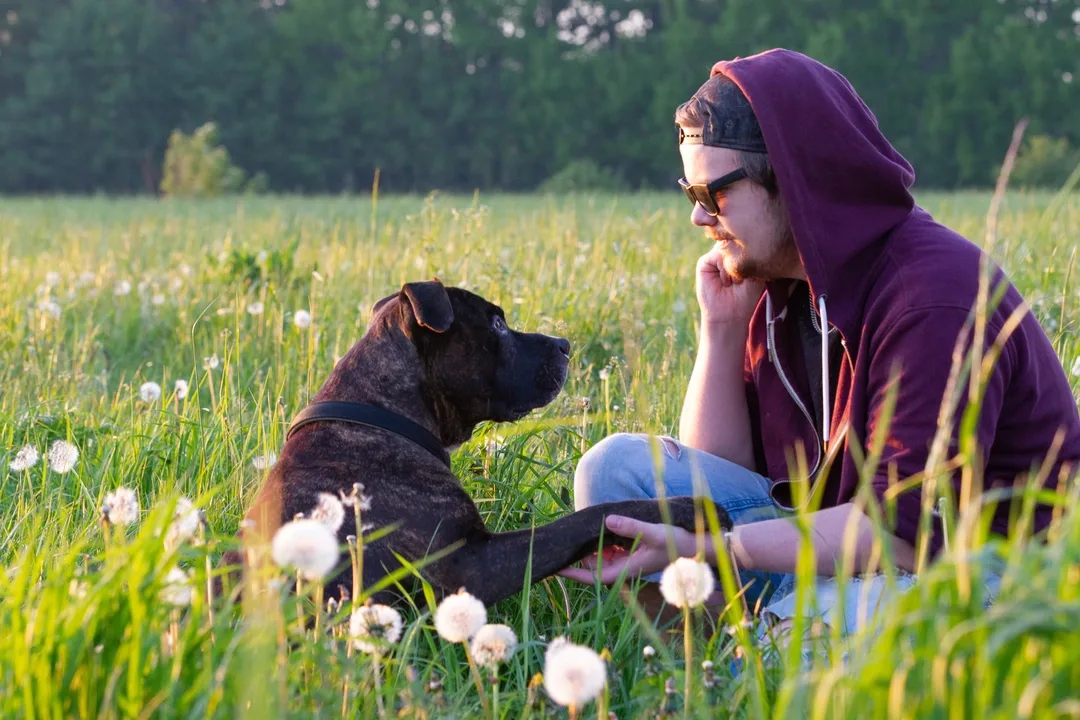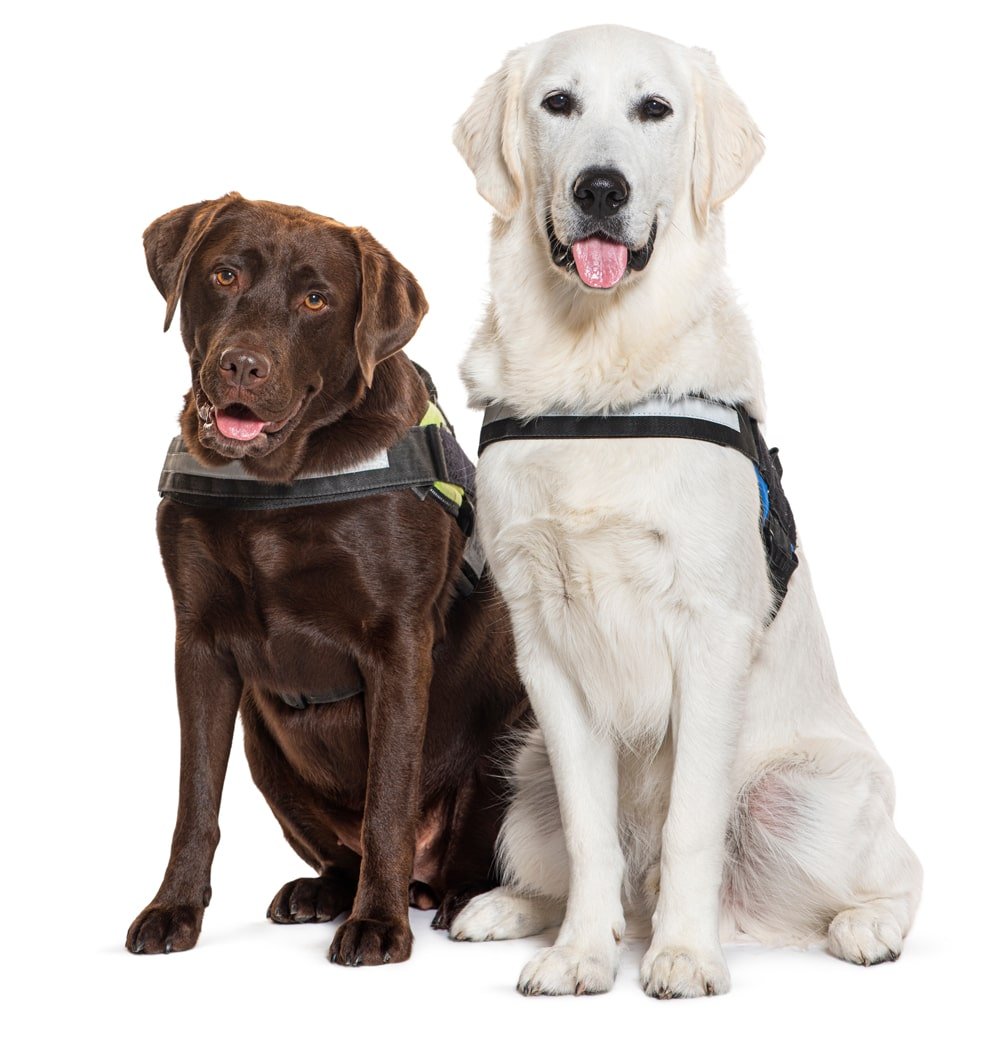Therapy Dog Training
Train your dog to provide emotional comfort and support to those who need it most.

Specialized Training for Therapy Dogs
At The Art of Dog Training, we offer specialized training to help your dog become a certified therapy dog, capable of bringing comfort, joy, and healing to people in hospitals, schools, nursing homes, and more.
Therapy dogs provide invaluable support to individuals and communities. They offer comfort and companionship in settings such as nursing homes, hospitals, therapists’ offices, and schools, where their calm and friendly demeanor makes a positive impact on people’s emotional and mental well-being.
At The Art of Dog Training, we specialize in training therapy dogs to be well-socialized, calm, and respectful of personal boundaries. Whether your dog is greeting patients in a hospital or comforting students in a classroom, our training ensures they behave appropriately and bring joy to those they support.
What is a Therapy Dog
A therapy dog is a dog trained to provide affection, comfort, and emotional support to individuals in settings such as hospitals, nursing homes, schools, and disaster relief areas. These dogs are invaluable for improving mood, reducing anxiety, and fostering social interaction. Therapy dogs are known to alleviate stress and loneliness while promoting optimism and healing.
Therapy dogs differ from service dogs in that they do not perform specific tasks for individuals with disabilities, and they do not have legal access rights under the Americans with Disabilities Act (ADA). However, they provide essential emotional benefits to individuals who need companionship, comfort, and care.
Therapy Dog Roles and Responsibilities
Therapy dogs play a vital role in many community settings:
- Nursing Homes: Providing emotional comfort to residents, improving their quality of life.
- Hospitals: Offering emotional support and reducing anxiety for patients during medical treatments.
- Therapists’ Offices: Helping clients feel at ease during therapy sessions by providing a calming presence.
- Schools: Assisting children with emotional and developmental needs, promoting a positive learning environment.
What Do Therapy Dogs Do?
Therapy dogs provide comfort and affection to those in need. Their roles include:
- Offering emotional support to patients, students, or the elderly in hospitals, nursing homes, schools, and other facilities.
- Improving patient outcomes by reducing pain, anxiety, and stress, which can aid in the healing process.
- Encouraging socialization for people who may feel isolated, such as residents in nursing homes or students with special needs.
- Promoting optimism and enhancing mood for individuals undergoing difficult circumstances, from patients in hospitals to survivors of trauma.
These dogs are often seen providing comfort in disaster relief areas, hospice care, and even airports, where their presence helps to calm anxious travelers. Their calming effect makes them valuable in a wide range of environments.
Why Therapy Dogs are Important
Therapy dogs offer incredible benefits to individuals and communities:
- Reduction in Anxiety: Therapy dogs help reduce stress and anxiety in both medical and educational settings.
- Emotional Support: They provide comfort to those going through difficult times, such as hospital patients and residents in care homes.
- Improved Social Interaction: Therapy dogs encourage communication and engagement, especially for individuals who may struggle to interact with others.
Key Training Areas for Therapy Dogs
Our training covers the essential behaviors and skills therapy dogs need to succeed in their roles:
- Obedience Training: Teaching commands such as sit, stay, and come to ensure your dog is reliable in any situation.
- Socialization: Exposing your dog to various environments and people to ensure they are comfortable in different settings.
- Personal Boundaries: Training your dog to avoid jumping, licking, or excessive barking, which is crucial when interacting with vulnerable individuals.
- Special Greetings: We teach fun and friendly commands such as “go make a friend,” “shake,” or “high five” to ensure your dog can engage with people in a meaningful way, making those they interact with feel special and cared for.
Why Choose The Art of Dog Training for Therapy Dog Training?
Our therapy dog training program focuses on developing your dog’s ability to provide emotional comfort and support in a variety of environments, including hospitals, nursing homes, and schools. We work with dogs of all breeds and backgrounds, provided they have the right temperament for therapy work.
Calm and Gentle Behavior
Therapy dogs must remain calm under pressure, allowing people to interact with them by petting, hugging, or sitting close. Our training ensures your dog can comfortably interact with different individuals, including children, the elderly, and those in emotional distress.
Basic Obedience and Manners
Therapy dogs need to be highly trained, well-socialized, and able to understand personal boundaries such as not jumping up or licking people. We teach essential obedience commands to make sure your dog behaves appropriately in therapy settings.
Special Greetings
We also teach your dog special greetings such as “go make a friend,” “shake,” or “high five” to create special moments of interaction, ensuring that the people they are supporting feel important and special.
Puppy Training for Therapy Work
It is generally best to start therapy dog training with a young puppy. We can assist you in picking the right puppy for this job and provide the foundational training necessary for future success. This is an amazing service to the community, and we are passionate about helping dogs achieve this goal.
Our training prepares dogs for the Canine Good Citizen (CGC) test, often regarded as the first step in becoming a certified therapy dog.
Therapy Dog Certification
Our Therapy Dog Development Course includes eight private lessons focused on basic obedience and therapy dog-specific tasks. Upon completing the course, your dog will be ready to take the Canine Good Citizen (CGC) test, which is often required for therapy dog certification. The course covers:
- Socialization and Public Access Skills: Teaching your dog to remain calm and friendly in public places like hospitals, nursing homes, and schools.
- Obedience and Manners: Ensuring your dog can follow commands, walk politely on a leash, and interact gently with people, including those with physical limitations or emotional distress.
Once certified, your therapy dog will be equipped to offer emotional comfort and support in a wide range of environments.

The Therapy Dog Training Process
We follow a comprehensive, step-by-step process to prepare your dog to become a therapy dog. The goal is to ensure that your dog is not only obedient but also calm, confident, and capable of providing comfort in a variety of environments.
Phase 1: Basic Obedience and Socialization
The foundation of any good therapy dog is solid obedience and socialization. During this phase, we work on:
- Basic obedience commands such as sit, stay, down, and come, ensuring your dog can follow instructions quickly and confidently.
- Socialization with people, other dogs, and different environments. Your dog must be able to remain calm and friendly around strangers, loud noises, and unfamiliar places.
- Understanding personal boundaries, such as not jumping on people, licking, or engaging in behaviors that may be overwhelming to individuals with physical or emotional sensitivities.
Phase 2: Special Therapy-Specific Skills
In this phase, we introduce skills specific to therapy work, including:
- Staying calm in chaotic or busy environments, such as hospitals, nursing homes, and schools.
- Greeting behaviors like “go make a friend,” “shake,” or “high five,” which create special, positive interactions that make people feel supported and appreciated.
- Physical interaction readiness: Your dog will learn how to comfortably receive physical affection from various people, including children and the elderly. This ensures your dog can provide a calming presence and bring joy to those in need of companionship.
Phase 3: Canine Good Citizen (CGC) Certification Preparation
The final phase involves preparing your dog to pass the Canine Good Citizen (CGC) test, which is often required for therapy dog certification. During this phase, we focus on:
- Passing all CGC requirements, including walking on a loose leash, sitting politely for petting, responding to distractions, and more.
- Ensuring your dog can handle a variety of environments and situations while maintaining their calm demeanor.
Phase 4: Public Access and Therapy Work Preparation
This phase focuses on preparing your dog for public access, where distractions and unfamiliar surroundings are common:
- Building confidence in public spaces, ensuring your dog remains focused and calm, even in places like hospitals, schools, and rehabilitation centers.
- Teaching patience and attention: Your dog will learn how to sit or lie quietly for extended periods, allowing patients or individuals to approach them for comfort.
- Handling unpredictable situations: Your dog will be trained to respond calmly to sudden movements, loud noises, and other potential stressors, ensuring they are reliable in therapy environments.
Pricing for Therapy Dog Training
$2,495
7 in-home sessions, 24 group sessions
Everything included with the obedience package
The “Heel” command
2 of the included sessions in public
2 personalized greetings
Therapy vest/ID cards


How to Get Started
Is your dog ready to bring comfort and joy to others? Contact us today to schedule your free evaluation and learn more about our therapy dog training program.
Frequently Asked Questions
What is the difference between a therapy dog and a service dog?
A therapy dog provides emotional support and comfort to individuals in hospitals, schools, nursing homes, and other settings. Therapy dogs are not considered service dogs and do not have public access rights under the ADA. A service dog, on the other hand, is trained to perform specific tasks for a person with a disability and has legal protections allowing them to accompany their handler in public places.
What temperament is required for a therapy dog?
Therapy dogs must have a calm, friendly, and confident temperament. They should enjoy being around people, allow strangers to touch them all over, remain calm in loud or chaotic environments, and not react to sudden noises or movements.
How does my dog become a certified therapy dog?
To become a certified therapy dog, your dog must pass a certification test, such as the Canine Good Citizen (CGC) test. This includes demonstrating obedience, good manners, and the ability to remain calm and friendly in public environments.
What training does a therapy dog need?
Therapy dogs must complete training in basic obedience, including sitting politely for petting, walking on a loose leash, not jumping on people, and remaining calm in the presence of distractions. They should also be comfortable with strangers and have experience in different environments such as hospitals, schools, and care facilities.
Can therapy dogs help reduce anxiety or depression?
Yes, therapy dogs are known for their ability to reduce stress, anxiety, and depression in individuals. Research has shown that therapy dogs help improve mood, encourage social interaction, and promote healing in people who are undergoing stressful experiences.
What environments are therapy dogs commonly used in?
Therapy dogs are commonly used in hospitals, nursing homes, hospice facilities, schools, assisted living facilities, and disaster relief areas. They help improve emotional well-being, reduce anxiety, and bring comfort to individuals in these settings.
Can any dog become a therapy dog?
While many dogs can become therapy dogs with the right training and temperament, not all dogs are suited for this role. Dogs must be friendly, calm, patient, and at ease in a variety of situations. A therapy dog candidate must also enjoy human interaction and remain relaxed in chaotic or unpredictable environments.
